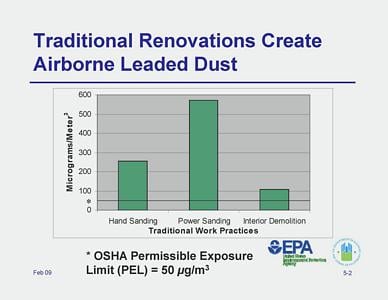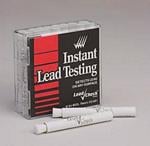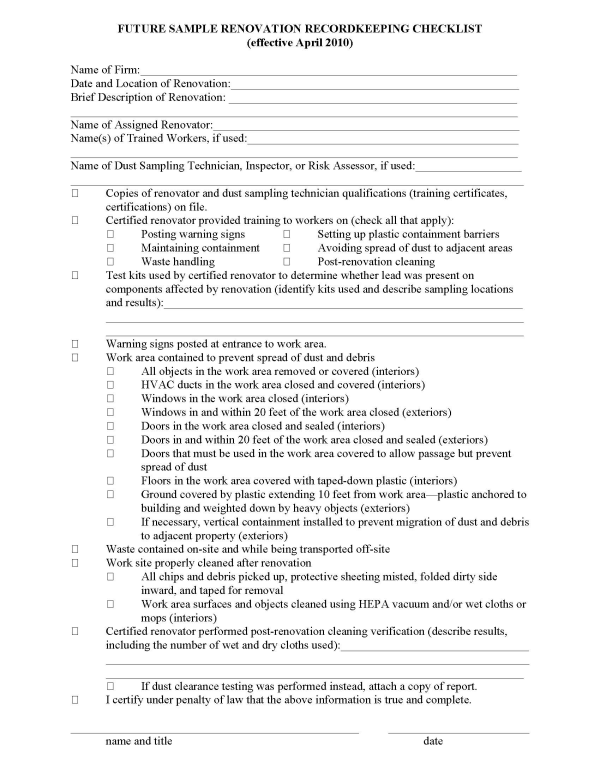
Renovators Intending to Comply With EPA RRP Rule May Be Blind-Sided by OSHA Requirements
The following article, written by Dick Hughes of Excellence In Safety, was forwarded to me last week by a colleague. Dick credits his sources at the end of the article. I also verified the accuracy of the information through one of my contacts at the Massachusetts DOS.

The article lists a variety of OSHA considerations that may likely blind-side well intentioned renovators as they attempt to comply with the new EPA RRP Rule. The RRP Rule and OSHA requirements are in conflict with each other in many ways. One EPA contact shared with me that EPA and OSHA did not collaborate on the rule while it was being written. This one consideration alone should raise serious doubt and concern for business owners about business liabilities and potential fines.
 If an EPA enforcement employee and and OSHA Field inspector show up at one of your jobsites, at the same time, there is no way you will be able to satisfy both. I suggest this is another example of shortsighted leadership within both organizations. It also points out the lack of knowledge and awareness our political leaders in Congress have as it relates to understanding the construction industry and overseeing the creation of regulations that affect businesses of all sizes.
If an EPA enforcement employee and and OSHA Field inspector show up at one of your jobsites, at the same time, there is no way you will be able to satisfy both. I suggest this is another example of shortsighted leadership within both organizations. It also points out the lack of knowledge and awareness our political leaders in Congress have as it relates to understanding the construction industry and overseeing the creation of regulations that affect businesses of all sizes.
The Article:
Big Compliance Problems Ahead for Worker Safety
On April 22, 2010, the Environmental Protection Agency (EPA) implemented a rule that requires contractors that are hired to perform renovation, repair and painting (RRP) projects in homes, child care facilities, and schools built before 1978 that disturb lead-based paint to be certified and follow specific work practices to prevent lead contamination. This rule is expected to impact hundreds of thousands of employers and millions of employees.
EPA is already proposing an expansion of this rule into pre-1978 commercial facilities. That change will significantly expand the scope of employers and building owners covered by this new regulation. Failure to comply with this new regulation can result in fines as high as $65,000 per violation, including a potential prison term. The EPA will enforce violations of the new regulation starting on Oct. 1, 2010.
The new EPA rule includes the following requirements:
• The new EPA regulations require “firms” that disturb more than 6 square feet of paint per room (or more that 20 square feet on the exterior) in these pre-1978 buildings to become certified with the EPA and employ certified renovators who would train workers and oversee these projects.
• Firms include contractors who are hired to perform renovation, repair and painting work where paint is disturbed in the targeted housing.
• Building owners whose maintenance staff also disturb painted surfaces in targeted housing must also be certified and use certified renovators.
• Certified firms must send a supervisor or “renovator” to an 8-hour class where they become certified to oversee work covered by the RRP rule.
Here’s the rub: The 8-hour class only covers the EPA requirements and completely ignores OSHA worker protection rules. Therefore, safety professionals might find that “Certified Firms” are violating OSHA lead regulations because they were not taught about OSHA requirements for worker protection. This is going to be a huge issue for employers whose employees are exposed to lead hazards during work covered by the new EPA RRP rule.
EPA Rule Doesn’t Fulfill OSHA Requirements
Employers and building owners should be alert to the fact that OSHA rules differ significantly from the EPA RRP regulations. OSHA lead regulations apply to any work where employees come into contact with any level of lead or lead bearing coatings. They should also note the following worker protection and/or OSHA omissions in the new EPA lead-based paint rule:
• Lead-based paint. The EPA RRP rule defines lead-based paint as containing more than 0.5 percent lead by weight. Lead coatings below this threshold are exempt from any special EPA certification, training or work practices. However, OSHA regulates lead in any amount. Therefore, many employers will believe that lead-coated surfaces below the EPA standards of 0.5 percent by weight are not regulated when in fact they may still be regulated by OSHA.
• Regulated areas.OSHA mandates under 1926.62 that employers establish “regulated areas” when lead or lead-coated surfaces are disturbed. A regulated area requires specific OSHA signage. The EPA signs required by their new RRP rule do not meet OSHA requirements for a regulated area.
• Written compliance program. OSHA regulations require a detailed compliance program listing specific requirements for employers to document. The EPA RRP rule does not have any requirements or discussion of a written compliance plan.
• Mandatory respirator use. OSHA lead regulations require monitoring for employees exposed to lead dust or fumes during work. OSHA has established three work class tasks for which certain exposures above the permissible exposure limit (PEL) must be assumed when employers fail to perform exposure monitoring. All of the work practices covered by the EPA RRP rule require employee respiratory protection under OSHA. However, the EPA required training only discusses respirator use as optional. The EPA training does not discuss OSHA regulations for a written respirator program, medical clearance, respirator training and fit testing for employees who are required to wear respirators.
• Protective clothing. OSHA lead regulations require protective clothing when work tasks disturb lead coatings (without a negative exposure assessment). OSHA requires either disposable clothing or employer laundering. The EPA RRP rule lists disposable clothing as optional and trains workers to use HEPA vacuums to clean clothing before going home. OSHA also requires employers to notify other employees or employers who would launder the contaminated clothing. The EPA RRP rules do not provide any awareness for employees who launder their own contaminated work clothing.
• Annual training. OSHA regulations require annual training when airborne levels of lead dust or fumes exceed their action level. EPA’s new RRP rule only requires training every 5 years.
• Hygiene facilities. OSHA regulations require a separate area to change from work clothing to street clothing as well as providing for hand/face washing facilities. The EPA does not address change facilities and suggests that workers wash their hands and face prior to leaving the work place.
• Medical surveillance and biological monitoring. OSHA mandates biological monitoring for employees exposed above the action level for airborne lead dust and fumes. The EPA RRP rule briefly mentions that the only way to detect lead in your blood is with a blood test and does not inform the workers of the OSHA requirement for biological monitoring.
The new EPA RRP lead-based paint rule is an important regulation for reducing the unacceptable levels of elevated lead in children’s blood in certain areas of the country. However, this huge piece of legislation has done a disservice to the millions of workers who will be impacted by lead during common renovation, repair, and painting activities in residential and child occupied facilities by ignoring mandatory worker protection requirements mandated by OSHA. Contractors and building owners must take extra steps to ensure that their workers or employees of contractors disturbing lead bearing substances in their facilities are thoroughly trained and protected in all applicable regulations; specifically OSHA worker protection rules for lead.
Thanks to:
Jeffery C. Camplin, MS, CSP is president of Camplin Environmental Services Inc., a safety and environmental consulting firm based in Rosemont, Ill. He is a licensed lead risk assessor and accredited EPA lead-based paint instructor for abatement courses and the new RRP rule training.
Useful links related to this article:
• July 21 Virtual Audioconference: EPA’s New Lead Paint Regulations Will Get You in Trouble with OSHA http://www.workplacetrainingcenter.com/Prod-2067.aspx
• EPA information on the new RRP rule for lead-based paint can be found at http://www.epa.gov/lead/pubs/toolkits.htm
• HUD information on lead safe work practices for renovation work can be found at http://www.hud.gov/offices/lead/training/rrp/rrp.cfm
• OSHA information on worker protection for employees exposed to lead-bearing substances can be found at http://www.osha.gov/SLTC/lead/construction.html
About the author:
Dick Hughes
Excellence In Safety
24 Spring Bars Road Falmouth, MA 02540
Web: www.excel-in-safety.com
capesafetyguy@aol.com
1-508-548-0866
cell: 1-617-653-4950
This article was originally published at Work Place Magazine
 While at the workshop I found one thing the main instructor Darcy Cook of Safety Trainers said to be very important for contractors to be aware of. Under the OSHA Lead in Construction Standard, contractors must assume their employees will be exposed to lead above OSHA’s established action level requiring the use of respirators until they actually conduct air monitoring testing to prove otherwise.
While at the workshop I found one thing the main instructor Darcy Cook of Safety Trainers said to be very important for contractors to be aware of. Under the OSHA Lead in Construction Standard, contractors must assume their employees will be exposed to lead above OSHA’s established action level requiring the use of respirators until they actually conduct air monitoring testing to prove otherwise.
 So, under OSHA requirements, before allowing them to do RRP related work or even enter a contained work area, employees must first be sent to a physician to be sure they are healthy enough to wear a respirator. Then they must be fit tested by a professional and provided with a properly fitted respirator that protects them from worst case lead exposure scenarios based on the kind of work they do. They must also be trained how to select, use, clean and store a respirator. And, they must wear the respirator until the air monitoring testing is done to identify when a respirator is required and when it is not depending on how the work is performed and what engineering controls are being used.
So, under OSHA requirements, before allowing them to do RRP related work or even enter a contained work area, employees must first be sent to a physician to be sure they are healthy enough to wear a respirator. Then they must be fit tested by a professional and provided with a properly fitted respirator that protects them from worst case lead exposure scenarios based on the kind of work they do. They must also be trained how to select, use, clean and store a respirator. And, they must wear the respirator until the air monitoring testing is done to identify when a respirator is required and when it is not depending on how the work is performed and what engineering controls are being used.
 Looking for accurate information about the EPA RRP rule?
Looking for accurate information about the EPA RRP rule?  Being a landlord brings with it many legal responsibilities related to lead paint that, if not followed, can certainly eat away at any potential profits. There are many rules to consider and be aware of, the most common being the
Being a landlord brings with it many legal responsibilities related to lead paint that, if not followed, can certainly eat away at any potential profits. There are many rules to consider and be aware of, the most common being the  When work is done inside their units, tenants must be given an EPA published pamphlet titled “Renovate Right”. The pamphlet explains the dangers of lead and what is required to protect their and their family’s health and safety when work is being done at the property where they live. If work is to be done in common areas, the pamphlet can either be given to tenants, or, notices can be posted telling tenants how they can receive the pamphlet at no cost to them. Tenants must also be given or made aware how they can request a document titled the
When work is done inside their units, tenants must be given an EPA published pamphlet titled “Renovate Right”. The pamphlet explains the dangers of lead and what is required to protect their and their family’s health and safety when work is being done at the property where they live. If work is to be done in common areas, the pamphlet can either be given to tenants, or, notices can be posted telling tenants how they can receive the pamphlet at no cost to them. Tenants must also be given or made aware how they can request a document titled the  If the landlord does his own work on the rental property and or uses his/her own employees to do so, the landlord must also become an EPA Certified RRP firm and only use trained and certified workers to do the work. If you are a landlord doing your own work,
If the landlord does his own work on the rental property and or uses his/her own employees to do so, the landlord must also become an EPA Certified RRP firm and only use trained and certified workers to do the work. If you are a landlord doing your own work,  NOTE: If you are a landlord, realtor or member of a group representing landlords or realtors seeking help and information about the RRP rules, feel free to
NOTE: If you are a landlord, realtor or member of a group representing landlords or realtors seeking help and information about the RRP rules, feel free to  Deleading under the MA Lead Law requires the removal or covering of
Deleading under the MA Lead Law requires the removal or covering of  At a recent
At a recent 


 RRP Assessment report or from a Lead Safe Renovator who has used an EPA approved lead based paint test kit to test surfaces for lead, to all tenants or potential buyers.
RRP Assessment report or from a Lead Safe Renovator who has used an EPA approved lead based paint test kit to test surfaces for lead, to all tenants or potential buyers. Many contractors seeking to comply with the new EPA RRP rule are reporting concerns and challenges about finding trade partners who are willing to operate in compliance. Many renovators have told me that their trade partners have flat out refused to get their businesses and workers certified. Others have said their trade partners have committed to do so but have been slow to get it done due to the related costs. This has become quite an opportunity for some trade partners who have become certified and are marketing their certifications and services to general contractors. Several are actually offering to sub-contract the set-up, containment, demo, clean-up, cleaning verification and all related and required documentation for general contractors.
Many contractors seeking to comply with the new EPA RRP rule are reporting concerns and challenges about finding trade partners who are willing to operate in compliance. Many renovators have told me that their trade partners have flat out refused to get their businesses and workers certified. Others have said their trade partners have committed to do so but have been slow to get it done due to the related costs. This has become quite an opportunity for some trade partners who have become certified and are marketing their certifications and services to general contractors. Several are actually offering to sub-contract the set-up, containment, demo, clean-up, cleaning verification and all related and required documentation for general contractors. Who will take care of the notification requirements and documentation of same before the job begins? Under the rule, either can do so, but the business under contract with the property owner must maintain the required documentation.
Who will take care of the notification requirements and documentation of same before the job begins? Under the rule, either can do so, but the business under contract with the property owner must maintain the required documentation. The first time a RRP fine is accessed for a violation the finger pointing will start, causing one or both businesses to get serious about certification and compliance. The first time a renovator is sued by a client or neighbor as a result of the actions of a trade partner, the tactics used by the lawyers will cause both businesses to have a new and different outlook on RRP compliance, insurance coverage amounts and indemnification clauses.
The first time a RRP fine is accessed for a violation the finger pointing will start, causing one or both businesses to get serious about certification and compliance. The first time a renovator is sued by a client or neighbor as a result of the actions of a trade partner, the tactics used by the lawyers will cause both businesses to have a new and different outlook on RRP compliance, insurance coverage amounts and indemnification clauses.  To confuse matters even further, under their definition of the difference between an employee and an independent contractor, the IRS says that a contractor cannot supervise the work or workers of a sub contractor. Doing so might result in the IRS labeling the sub contractor as an employee. If this were to happen it could trigger addition payroll taxes and workers compensation costs for the general contractor.
To confuse matters even further, under their definition of the difference between an employee and an independent contractor, the IRS says that a contractor cannot supervise the work or workers of a sub contractor. Doing so might result in the IRS labeling the sub contractor as an employee. If this were to happen it could trigger addition payroll taxes and workers compensation costs for the general contractor.
 One way to think about this might be to relate it to eating fish. The government often says that if you fish in certain bodies of polluted water, you can safely eat up to so many of the fish you catch without any health concerns. If the government says you can eat up to 3 fish a year, how safe would you feel eating even one fish? Using this analogy, how safe might the owner feel having renovations done if there is any lead present at all at their property?
One way to think about this might be to relate it to eating fish. The government often says that if you fish in certain bodies of polluted water, you can safely eat up to so many of the fish you catch without any health concerns. If the government says you can eat up to 3 fish a year, how safe would you feel eating even one fish? Using this analogy, how safe might the owner feel having renovations done if there is any lead present at all at their property?

 If an EPA enforcement employee and and OSHA Field inspector show up at one of your jobsites, at the same time, there is no way you will be able to satisfy both. I suggest this is another example of shortsighted leadership within both organizations. It also points out the lack of knowledge and awareness our political leaders in Congress have as it relates to understanding the construction industry and overseeing the creation of regulations that affect businesses of all sizes.
If an EPA enforcement employee and and OSHA Field inspector show up at one of your jobsites, at the same time, there is no way you will be able to satisfy both. I suggest this is another example of shortsighted leadership within both organizations. It also points out the lack of knowledge and awareness our political leaders in Congress have as it relates to understanding the construction industry and overseeing the creation of regulations that affect businesses of all sizes.
 EPA recognizes that, when used by trained professionals, the
EPA recognizes that, when used by trained professionals, the 
 PA
PA Rhode Island administers their own RRP program. Here is an addition documentation consideration related to the renovation record keeping for those operating in RI:
Rhode Island administers their own RRP program. Here is an addition documentation consideration related to the renovation record keeping for those operating in RI: According to the EPA web site:
According to the EPA web site:


